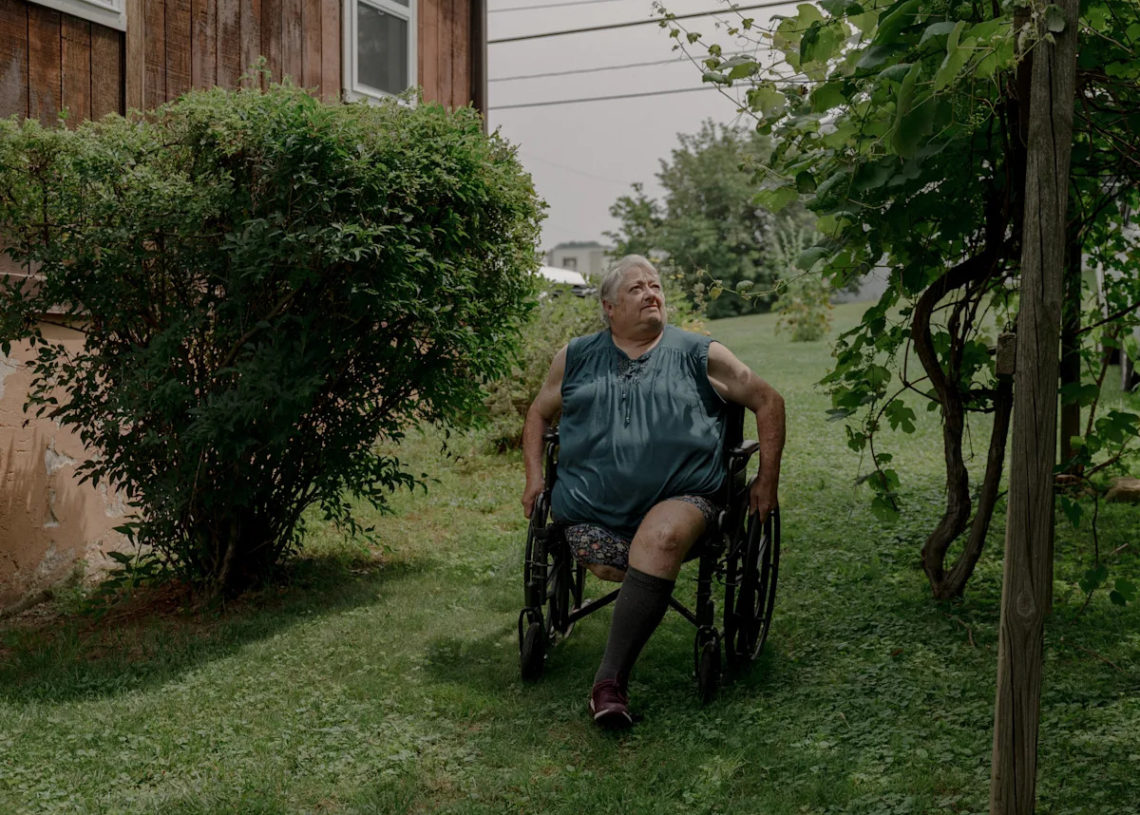ELKTON, Md. – Debbie Blankenship’s wheelchair carved perfect lines in the grass as she rolled into her backyard garden, passing a wooden arch filled with small grapes, a bush with plump blueberries and yellow crates filled with sprouting potatoes.
She stopped at a dirt patch with a burial marker for her beagle – the latest of her dogs to die of cancer.
“They are all buried back here. It’s like a pet cemetery,” she said, catching her breath from navigating the hilly terrain. Gazing at the burial site, she spoke about her own long battle with cancer.
For decades, Blankenship chalked up her health problems, including losing her right leg to an infection, to bad luck. Then in 2023 she received a phone call from W.L. Gore & Associates, which makes waterproof membranes such as Gore-Tex and a host of other products. Gore wanted to test Blankenship’s well water for PFOA, a highly toxic “forever chemical” that was used to make PTFE, commonly known as Teflon.
“That’s when the light went off,” she said. She and her dogs were the only members of the household to drink the well water. Her husband and children always drank bottled water.
Gore’s offer to test Blankenship’s well came after a former employee named Stephen Sutton sued the company in 2022, claiming the company’s negligent use of per- and polyfluoroalkyl substances, known as PFAS, harmed workers and the surrounding community. The litigation triggered a public water crisis: A class-action lawsuit was filed the following year, and Maryland filed suit in 2024.
These stable chemical compounds tend to persist indefinitely in the environment, as well as in the human body. They have been linked to serious health problems including high cholesterol, cardiovascular disease, infertility, low birth weight and certain cancers.
The lawsuits claim that the company knew for decades that its use of these chemicals endangered public health and the environment but hid that fact from the state and the nearby community. Gore has denied concealing information about the presence of PFOA in its materials or any potential risks.
Maryland’s Department of the Environment and Cecil County declined to comment, citing the pending litigation. In a statement made when the state filed its lawsuit, Maryland Attorney General Anthony G. Brown (D) said, “It is unacceptable for any company to knowingly contaminate our drinking water with these toxins, putting Marylanders at risk of severe health conditions.”
Gore said in a statement that it has never manufactured PFOA and that only “trace levels” were present in raw materials purchased from suppliers. The company said all its vendors must now certify their materials are made without it.
“We dispute the allegations in the lawsuit filed by the State of Maryland and deny the allegations in the Sutton matter,” said Amy Calhoun, a spokeswoman for Gore.
– – –
Poisoned wells
Gore has helped anchor Elkton’s economy for more than 50 years. The privately held company, based in Delaware, operates 14 facilities in and around Cecil County. It reports $5 billion in revenue, employs more than 3,100 residents and has created a deep relationship with the community.
A wooden sign near the entrance of Kenmore Elementary School reads: “In partnership with W.L. Gore & Associates.” A thin line of trees is the only barrier separating the school from Gore’s Cherry Hill facility, where PTFE was received in powder form and transformed into products.
Blankenship’s husband, Richard, who suffers from Alzheimer’s, worked at Gore for nearly 40 years.
Water samples taken from Blankenship’s well in May 2023 showed PFOA concentrations of 3.4 parts per trillion (ppt), according to documents reviewed by The Washington Post, below the Environmental Protection Agency’s maximum contaminate level of 4 ppt. However, the agency has said that there is no safe level of exposure and that small amounts of the chemical can cause serious health impacts, including cancer.
Other well water samples from Blankenship’s neighbors across the street from Gore’s Cherry Hill site revealed PFOA concentrations as high as 800 ppt, according to tests conducted throughout 2023 by Gore and the Maryland Department of the Environment. Groundwater samples from the site were as high as 1,300 ppt. Monitoring wells near Gore’s Fair Hill site contained concentrations of 1,800 ppt, while a nearby stream had PFOA concentrations of 740 ppt.
Gore’s Calhoun acknowledged “some isolated numbers” at high concentrations in well water but said the impact on groundwater at the Cherry Hill facility was “limited.”
“We do know now that a limited amount of PFOA has been released as part of our historic operations and in concentrations that by today’s standards are higher than acceptable,” she said. “Most importantly, Gore is committed to addressing the issue.”
The scope of the contamination from Gore’s facilities is not yet known. Sutton alleges in his suit that Gore knew by the late 1980s, through its own groundwater testing, that pollution from its Cherry Hill plant could travel to neighboring properties.
Philip Federico, an attorney at Brockstedt Mandalas Federico who represents Elkton residents, said in a statement that the firm filed suit because Gore knew about the risks of PFAS for four decades and continued dumping toxic chemicals into the community.
“Today, both the residents and agricultural interests of these communities are dealing with the life-altering consequences of PFAS exposure, including cancer, reproductive and fertility challenges, developmental delays, hypertension, and more,” Federico said.
Gore said it eliminated PFOA from its supply chain in 2014. DuPont and other manufacturers agreed to phase out the chemical in the United States by 2015 under a voluntary agreement with the EPA. In recent years, the chemical industry has reached large settlements with states and local communities over PFAS contamination of public water supplies.
The EPA estimates that more than 158 million Americans are exposed to PFAS through their drinking water.
Unlike water from public water utilities, private wells are not subject to federal water regulations. Gore offered Blankenship and other residents within sampling areas around its facilities the choice of filtering their well water or connecting their homes to the local water utility. The company said it has installed 84 filtration systems and connected 13 homes to the utility.
While Blankenship is waiting for the county hookup, she is drinking bottled water provided by Gore and uses rainwater in her garden.
Linda Birnbaum, a former director of the National Institute of Environmental Health Sciences, said that based on the water sample results near the Cherry Hill plant, many of the nearby wells should be capped and closed because “it would be very difficult to clean them up.”
“If this was a public water supply, those would have to be remediated,” she said. “In many of the wells, their levels of PFOA are of concern.”
– – –
Chemical dreams
Mark Strickler, 68, who moved to Cherry Hill after landing a job at Gore more than 40 years ago, said he sometimes dreams he is back on the production line. That is where he used to scoop up white PTFE powder and mix it with graphite and other materials to make fibers for industrial weaving applications and products such as dental floss. He said he was told by his supervisor that the chemicals were safe.
He recalled some “pretty nasty” times, when the odor from the chemicals gave him headaches or the PFAS-soaked scrap material would leave his hands numb for half an hour. Even so, Strickler said he recalls his time at Gore with fondness.
Then he wakes up to a harsh reality of the drinking-water contamination in his community.
“It was a surprise to me,” Strickler said. “I’m disappointed in the company for polluting, when I thought they were more concerned about the culture of the company.”
Despite his disappointment, Strickler said he considers Gore a good employer. After an aneurysm years ago, a graft created by Gore was inserted in his heart during one of his five heart operations, three of which required him to be “cut open like a lobster.”
Blankenship, who wakes up in pain that she can only compare to that of childbirth, praised Gore even though she believes the company’s operations could have contributed to her health problems.
“They’ve taken care of us. They were good to us. They’re good to their employees,” she said. Richard was still working at the company when they heard about the class-action lawsuit.
Last month marked the couple’s 49th wedding anniversary. Instead of treating her illnesses in the hospital, she wanted to spend whatever time she has left at home with her husband.
“I’m tired of my body being invaded by tests and needles,” she said, sitting in a wheelchair on her porch. “I’m just tired of battling, so I’ll take my chances. I’ve laid it all on Jesus’ feet.”
Now she makes sure her dog drinks only from the three-gallon water jugs Gore delivers every month, saying she was determined to end the cycle.
“It was really too late,” Blankenship said. “That’s why I said the next dog we got, she will never drink the water.”
Related Content
Ukraine scrambles to roll back Russian eastern advance as summit takes place
Her dogs kept dying, and she got cancer. Then they tested her water.
D.C.’s homeless begin to see the effects of Trump’s crackdown
The post Her dogs kept dying, and she got cancer. Then they tested her water. appeared first on Washington Post.



